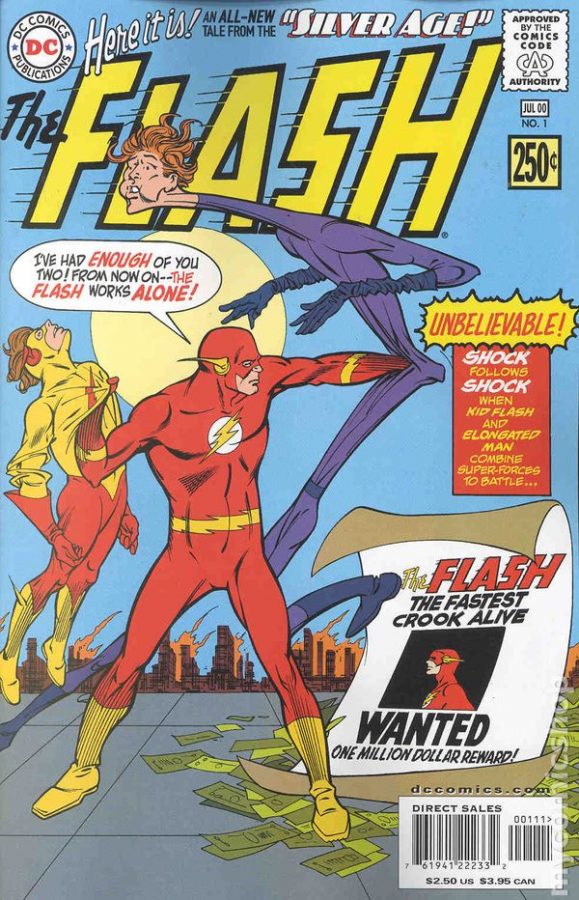The Silver Age of Comics
January 23, 2020
Many people may not know what the “Silver Age of Comics” means, but pretty much everyone has seen one of those goofy old comic covers where absolutely nothing makes sense. Like in Action Comics #243, when lion-headed Superman said to Lois Lane, “Yes, Lois, I’m Superman! But a strange fate has changed my form. Now you and I must act out a modern version of Beauty and the Beast.” Why? The world may never know.
Depending on who you ask, there are roughly five ages of comics. The golden age, silver age, bronze age, dark age, and the modern age, which are the comics you read now. In the Golden Age all of our favorite heroes were introduced, Batman, Superman, Wonder Woman, Captain America. The war was going on and these superheroes were busy fighting the Japanese or Hitler. But what happened when the war ended? There was no one left for the heroes to fight and people lost interest in Superhero comics, genres like horror and romance were on the rise. And that marks the end of the Golden Age.
If you walk into a comic store today you’ll probably see the new issue of Grant Morrison’s Green Lantern on the shelves. But that wouldn’t be if it weren’t for psychiatrist Fredric Wertham’s book Seduction of the Innocent. He explained that comics were too violent and they were corrupting children. This sparked many senate debates and the eventual creation of the Comics Code Authority, or ‘The Comics Code.’ On an old comic you might see a sticker that says “approved by the comics code authority.” The Comics Code set many strict guidelines for what can be in a comic. As a result you don’t get any of the serious stuff from the Golden Age, you get Superman saying, “Using my steel strong hair as a mop, I can rub every spot of this sticky syrup!” That’s good stuff. Publishers didn’t have to oblige with the code, but the sticker on the front of their books was reassurance to the consumers that there was nothing bad in the comics. This got people reading again.
There is much debate over how the Silver Age ended, but it’s clear what started it. Showcase Comics #4 (1956), the introduction of Barry Allen. After The Flash we saw the return and rise of Green Lantern. During the beginning of the Silver Age, DC was the leading publisher, while their biggest competitor, Fawcett comics, was wrapped up in a big lawsuit. Because of their success, Stan Lee’s boss over at Marvel asked him to create a superhero team that could rival the Justice League. Thus is born the Fantastic Four (1961). Then X-Men, Spiderman, putting Marvel at the top next to DC.
As silly, childish, and irrational as the silver age is, every comic today owes something to it. It brought about the Big Two of comics, Marvel and DC, characters that were dying out came back and new ones were created. It set the pace for everything to come. So why did it end? How did comics come to be the serious (most of the time) medium they are? It’s hard to say for sure because no one is really sure when it ended. The time range is late-sixties to mid-seventies. Some say the bronze age started when the price of comics went from twelve cents to fifteen. Others say It happened when Jack Kirby, the creator of Mister Miracle and the New Gods, left Marvel and went over to DC. Maybe it was when they shrunk the size of comics, which they had been doing every ten years or so since the 1940s. Comic historian Arnold T. Blumberg says It happened when Spiderman’s girlfriend Gwen Stacy died. He said the era of innocence, which is what the silver age is really known for, ended with “the snap heard round the comic book world,” which was the sickening snap of bone that marked her death. While this may have contributed to comics moving on and becoming more serious, it likely didn’t end the silver age because this only shocked Spiderman fans. Over time publishers stopped caring about the comics code and wrote whatever they want, and people kept reading.
Some publishers and writers later realized what they had done with the silver age. Some didn’t. Crisis on Infinite Earths, a 12 issue maxi-series from 1985, was the first of seven crisis and the first of three reality altering events of the DC universe. It was also an attack on the silver age. This sparked the neo-silver movement in 1986, a response to the crisis and a return to silver age principles. But neo-silver comic creators wrote using the more sophisticated aspects of the silver age. Not stuff like Detective Comics #241, in which Robin asks Batman why he wore the green bat costume last night and the red one today, and Batman replies, “I must Robin – I must wear a different colored Batman costume each night.”
Comics are much more sophisticated now. DC just wrapped up Doomsday Clock, which after much, much work, Dr. Manhattan released the past and the state of the universe returned to a more post-crisis/pre-flashpoint setting, and this 12 issue maxi-series will probably go down as the eighth crisis of the DCU. Marvel now has Miles Morales, a black Spiderman, same goes for Captain Marvel. But if you look very closely, you can catch some of that silver age charm. Like Jarro. After the telepathic alien starfish and future president of America, Starro the Conqueror, died in No Justice, a small part of him survived, because he’s a starfish. That small part lives in a jar in the Hall of Justice, hence the name Jarro. He dresses up as Robin and calls Batman “dad.” I guess anyone can write comics.



